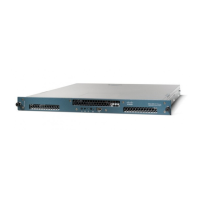4-47
Cisco 4700 Series Application Control Engine Appliance Administration Guide
OL-11157-01
Chapter 4 Configuring Class Maps and Policy Maps
Configuring a Layer 3 and Layer 4 Policy Map
The syntax of the class command with the optional insert-before keyword is:
class m
ap_name1 insert-before map_name2
When you use this command, the ACE places the current
class map (as specified
by the map_name1 argument) ahead of an existing class map (as specified by the
map_name2 argument).
For example, to define the sequential order of two class maps in the policy map,
ente
r:
host1/Admin(config-pmap-c)# class L4_HTTP_APP_INSPECTION_CLASS
insert-before L4_SLB_VIP_CLASS
To specify the class-default class map for the Layer 3 and Layer 4 traffic policy,
use the class class-default command in policy map configuration mode. All
network traffic that fails to meet the other matching criteria in the named class
map belongs to the default traffic class. If none of the specified classifications
match, the ACE then matches the action specified under the class class-default
command. The class-default class map has an implicit match any statement in it
and is used to match any traffic classification.
When you use this command, you will access policy map class configuration
mo
de.
For example, to use the class cl
ass-default command, enter:
host1/Admin(config-pmap)# class class-default
host1/Admin(config-pmap-c)# loadb
alance vip replicate-connections
Specifying Layer 3 and Layer 4 Policy Actions
To allow the network management traffic listed in the Layer 3 and Layer 4 class
map to be received or rejected by the ACE, specify either the permit or deny
command in policy map class configuration mode.
• Use the permit command in policy map class configuration mode to allow the
remote network management protocols listed in the class map to be received
by the ACE.
• Use the deny command in policy map class configuration mode to refuse the
remote network management protocols listed in the class map to be received
by the ACE.

